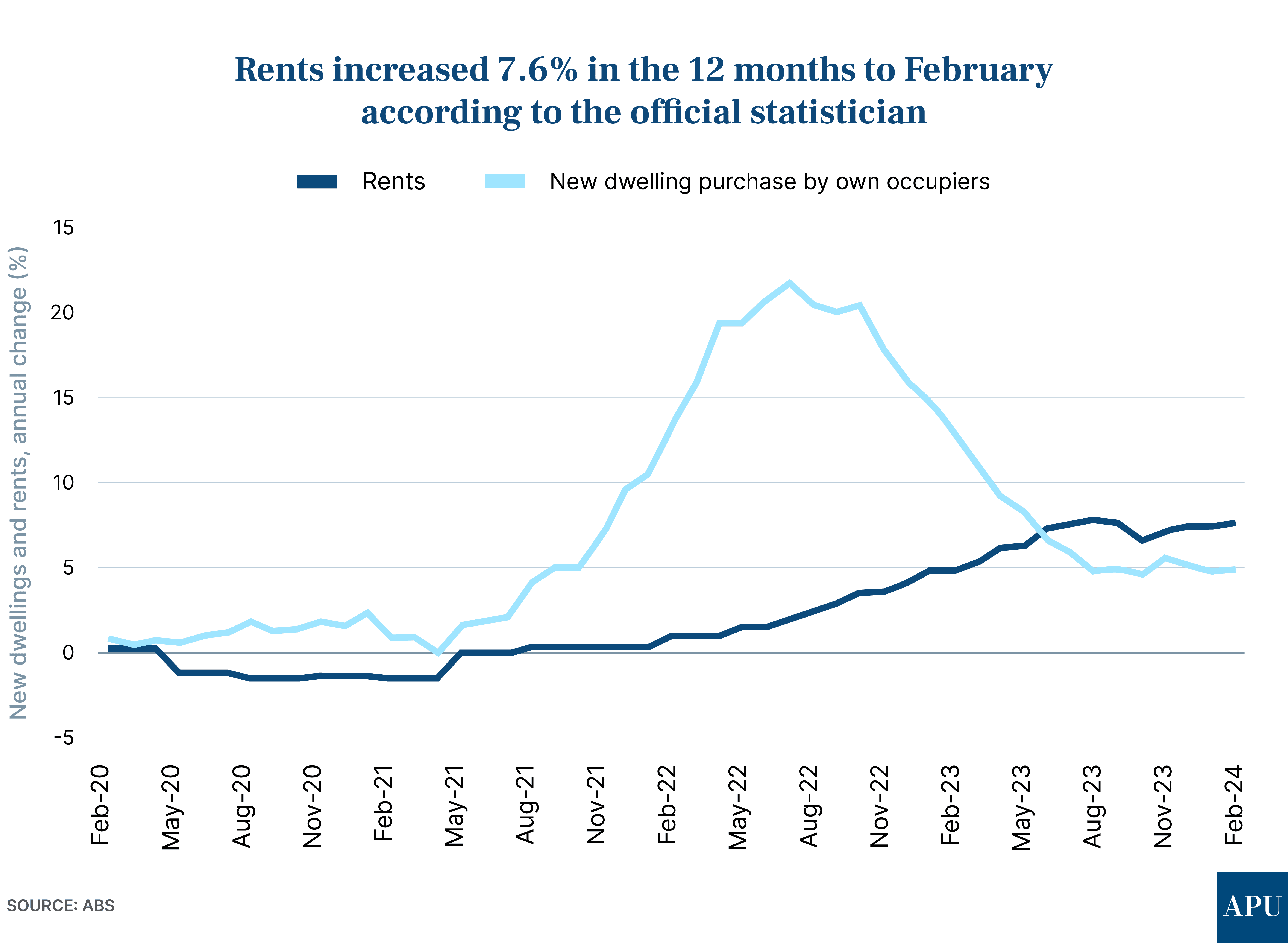Features > Property News & Insights > Housing Trends
Rate cuts back on the cards this year, as home prices continue to rise

KEY POINTS
- Monthly data shows annual inflation in Australia held steady in February at 3.4%
- Inflation continues to trend downwards, despite concerns a stronger-than-expected jobs market might start to reheat the economy
- Analysts say the inflation figures are in line with expectations the Reserve Bank will start cutting interest rates in the second half of the year
- The ABS figures show rents grew strongly by 7.6% in the year to February
- In yet more news about the strength of the housing market in the face of high-interest rates, new data shows 94% of home resales in the last three months of 2023 were profitable
Australians with a mortgage can breathe a bit easier today, following the release of the latest inflation data from the Australian Bureau of Statistics (ABS).
The monthly Consumer Price Index (CPI) numbers show annual inflation of 3.4% in the year to the end of February.
That number was unchanged from the previous two months, but slightly below market expectations, and will confirm to the Reserve Bank of Australia (RBA) that its painful strategy of jacking up interest rates is working, bringing down inflation and slowing the economy.
For most economists and the money markets, it’s yet more proof the next move in interest rates by the central bank will be down, and the cuts will start coming sometime in the second half of the year.
The numbers

ABS figures show annual inflation to the end of February was 3.4%, with the most significant price rises coming in housing (+4.6%), food and non-alcoholic beverages (+3.6%), alcohol and tobacco (+6.1%), and insurance and financial services (+8.4%).
When you look at the RBA’s preferred trimmed mean measure, annual inflation to the end of February was 3.9%, slightly up from 3.8% the previous month, but over time still tracking down towards the RBA’s target range of 2-3% - a target the RBA says must be achieved by the end of next year.
Westpac senior economist Pat Bustamante says the February inflation numbers are significant because they provide the first real update on services inflation, “which is really what the RBA is concerned about.”
“We got an updated read on education, for instance,” he says.
“The fact that it came in a bit softer than the market…what we were expecting, is definitely a positive result and is consistent with our view that inflation, both from the goods side, but domestically, is moderating.”
The slightly lower-than-expected inflation numbers also came as a relief, after recent strong employment numbers sent some analysts pushing back their forecasts of rate cuts this year, as the job figures appeared to suggest Australia’s economy was growing much more strongly than expected.
Pat Bustamante points to considerable volatility in monthly employment numbers and says when all the data is put together, the RBA will see a “consistent picture” that “the economy is slowing, inflation is moderating in line with what they're expecting, and that's probably what they'll be looking for before they next meet in May.”
Mr Bustamente says Westpac is still expecting the next move in interest rates to be down.
“These numbers…are completely consistent with our expectations,” he told ABC News, “At the moment, we feel that the Reserve Bank Board will be comfortable with reducing rates in the month of September.”
The Australian dollar fell slightly in the moments after the inflation data was released, indicating that the money markets felt the lower-than-expected number increased the chance that rate cuts would come earlier rather than later.
The housing market

Despite inflation continuing to fall, the ABS figures confirm housing continues to grow strongly.
Much of the ABS housing category is made up of rental growth.
It was up 7.6% in the year to February, which the Bureau says “continues to reflect strong demand for rental properties and tight rental markets.”
The other major portion of that category is new dwelling prices, which rose 4.9% in the 12 months to February.
The ABS says that “reflects builders continuing to pass on higher costs for labour and materials.”
Cheaper home prices are nowhere to be seen
The strength of housing has also been underlined by new figures from CoreLogic, released on the same day as the inflation numbers.
The data analytics firm found that despite no less than 13 straight interest rate rises from the RBA since May 2022, “the Australian property market continues to demonstrate sustained resilience, with the rate of profit-making sales and number of transactions increasing in the December quarter (of 2023).”
CoreLogic's latest “Pain & Gain” report looked at around 90,000 resales of properties that took place in October, November, and December of 2023.
It found at least 94% of transactions recorded at least some price gain.
In fact, the median gross profit rose to $310,000.
CoreLogic’s Head of Research Eliza Owen said the upward trajectory aligns with the sustained growth in home values observed throughout the year.
“The improvement in the key metrics of this report really highlights the improving profitability in the housing market since the recovery trend began in early 2023,” Ms Owen said.
“The broad-based increase in profitability and value across the Australian housing market helps to shore up financial stability at a time of stark increases in mortgage costs for some households,” she says.
Stay Up to Date
with the Latest Australian Property News, Insights & Education.




.png?width=292&height=292&name=Copy%20Link%20(1).png)
 SIGN UP FOR FREE NEWSLETTER
SIGN UP FOR FREE NEWSLETTER








.jpg?width=1920&height=1080&name=Warning%2c%20You%20Might%20Be%20Facing%20Higher%20Taxes%20Soon%20(1).jpg)





.png?width=1920&height=1080&name=Rate%20Drops%20Signal%20BIGGEST%20Property%20Boom%20in%20DECADES%20(1).png)

.jpg?width=1920&height=1080&name=Labor%20vs%20Liberal%20These%20Housing%20Policies%20Could%20Change%20the%20Property%20Market%20Forever%20(1).jpg)
.jpg?width=1920&height=1080&name=QLD%20Slashes%20Stamp%20Duty%20Big%20News%20for%20Investors%20%26%20Home%20Buyers%20(1).jpg)
.jpg?width=1920&height=1080&name=Trump%20Just%20Slapped%20Tariffs%20%E2%80%93%20Here%E2%80%99s%20What%20It%20Means%20for%20Australia%20(1).jpg)
.jpg?width=1920&height=1080&name=Federal%20Budget%202025%20More%20Debt%2c%20No%20Housing%20%E2%80%93%20Here%E2%80%99s%20What%20You%20Need%20to%20Know%20(1).jpg)
.jpg?width=1920&height=1080&name=Australias%20Housing%20Crisis%20is%20about%20to%20get%20MUCH%20Worse%20(New%20Data%20Warns).jpg)
%20(1).jpg?width=1920&height=1080&name=Australias%20RENTAL%20CRISIS%20Hits%20ROCK%20BOTTOM!%20(2025%20Update)%20(1).jpg)
%20(1).png?width=1920&height=1080&name=Is%20Adelaide%20Still%20a%20Good%20Property%20Investment%20(2025%20UPDATE)%20(1).png)
.jpg?width=1920&height=1080&name=RBA%20Shocks%20with%20Rate%20Cuts!%20What%E2%80%99s%20Next%20for%20Property%20Investors%20(1).jpg)
%20(1).jpg?width=1920&height=1080&name=I%20Predict%20The%20Feb%20Rate%20Cut%20(My%20Price%20Growth%20Prediction)%20(1).jpg)
.png?width=1920&height=1080&name=Why%20Property%20Prices%20Will%20Rise%20in%202025%20Market%20Predictions%20(1).png)
.jpg?width=1920&height=1080&name=Why%20Investors%20Are%20Choosing%20Apartments%20Over%20Houses%202%20(1).jpg)
.jpg?width=1920&height=1080&name=Why%20Rate%20Cuts%20Will%20Trigger%20A%20Property%20Boom%20(1).jpg)
.jpg?width=1920&height=1080&name=Retire%20On%202Million%20With%20One%20Property%20(Using%20SMSF).jpg)
.jpg?width=1920&height=1080&name=4%20Reasons%20Why%20You%20Should%20Invest%20in%20Melbourne%20Now%20(1).jpg)
%20(1).jpg?width=1920&height=1080&name=Old%20Property%20vs%20New%20Property%20(Facts%20and%20Figures%20Revealed)%20(1).jpg)
%20(1).jpg?width=1920&height=1080&name=Will%20The%20New%20QLD%20Govt%20Create%20a%20Property%20Boom%20or%20Bust%20(My%20Prediction)%20(1).jpg)
%20Scott%20Kuru%20(1).jpg?width=1920&height=1080&name=Inflation%20Hits%20Three-Year%20Low%20(Will%20RBA%20Cut%20Rates%20Soon)%20Scott%20Kuru%20(1).jpg)
.jpg?width=1920&height=1080&name=How%20to%20Buy%20Investment%20Property%20Through%20SMSF_%20The%20Ultimate%20Guide%20(1).jpg)
.jpg?width=1920&height=1080&name=Victoria%20Slashes%20Stamp%20Duty%20Melbourne%20Set%20to%20Boom%20Scott%20Kuru%20(1).jpg)
.png?width=1571&height=861&name=Are%20Foreign%20Buyers%20Really%20Driving%20Up%20Australian%20Property%20Prices%20(1).png)
.jpg?width=1920&height=1080&name=The%20Single%20Factor%20That%20Predicts%20Property%20Growth%20Regions%20(1).jpg)
%20Scott%20Kuru%20(1).jpg?width=1920&height=1080&name=My%20Prediction%20On%20Rates%20%26%20Negative%20Gearing%20(Market%20Crash)%20Scott%20Kuru%20(1).jpg)

-1.png?width=1920&height=1080&name=Major%20Banks%20Cut%20Rates%20Will%20RBA%20Follow%20Suit%20(Sept%20Rate%20Update)-1.png)
%20Scott%20Kuru-1.png?width=1920&height=1080&name=Rate%20Cut%20Coming%20What%20New%20Zealands%20Move%20Means%20for%20Australia%20(Sept%20Prediction)%20Scott%20Kuru-1.png)
%20(1).jpg?width=1920&height=1080&name=Buy%20when%20the%20interest%20rates%20are%20high!%20(Why%20you%20must%20buy%20now!)%20(1).jpg)
.jpg?width=1920&height=1080&name=Carms_Revised%20Taxes%20Due%20Aug%209%20YT%20Thumbnail02%20(1).jpg)
.jpg?width=1920&height=1080&name=Carms_Too%20Little%20Too%20Late%20Aug%207%20YT%20Thumbnail01%20(1).jpg)









.jpg?width=1920&height=1080&name=Carms_Rate%20Drop%20In%20July%20Jun%2010%20YT%20Thumbnail02%20(1).jpg)
.jpg?width=1920&height=1080&name=Carms_Own%20a%20Property%20V6%20Jun%205_YT%20Thumbnail%20(1).jpg)









.png?width=1920&height=1080&name=Artboard%201%20(3).png)






.jpg?width=1920&height=1080&name=YT%20thumbnail%20%20(1).jpg)

